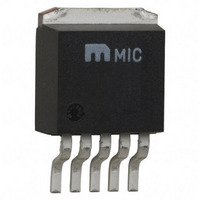MIC39150-1.65WU TR Micrel Inc, MIC39150-1.65WU TR Datasheet - Page 10

MIC39150-1.65WU TR
Manufacturer Part Number
MIC39150-1.65WU TR
Description
1.5A 1.0% Fixed Voltage LDO( )
Manufacturer
Micrel Inc
Datasheet
1.MIC39150-2.5WU.pdf
(14 pages)
Specifications of MIC39150-1.65WU TR
Regulator Topology
Positive Fixed
Voltage - Output
1.65V
Voltage - Input
2.25 ~ 16 V
Voltage - Dropout (typical)
0.375V @ 1.5A
Number Of Regulators
1
Current - Output
1.5A (Min)
Operating Temperature
-40°C ~ 125°C
Mounting Type
Surface Mount
Package / Case
TO-263-3, D²Pak (3 leads + Tab), TO-263AA
Lead Free Status / RoHS Status
Lead free / RoHS Compliant
Current - Limit (min)
-
Lead Free Status / RoHS Status
Lead free / RoHS Compliant
Other names
MIC39150-1.65WUTR
MIC39150-1.65WUTR
MIC39150-1.65WUTR
Application Information
The MIC39150/1/2 are high-performance, low-dropout
voltage regulators suitable for moderate to high-current
voltage regulator applications. Its 500mV dropout
voltage at full load and overtemperature makes it
especially valuable in battery-powered systems and as
high-efficiency noise filters in post-regulator applications.
Unlike older NPN-pass transistor designs, where the
minimum dropout voltage is limited by the base-to-
emitter voltage drop and collector-to-emitter saturation
voltage, dropout performance of the PNP output of these
devices is limited only by the low V
A trade-off for the low dropout voltage is a varying base
drive requirement. Micrel’s Super βeta PNP
reduces this drive requirement to only 2% to 5% of the
load current. The MIC39150/1/2 regulators are fully
protected from damage due to fault conditions. Current
limiting is provided. This limiting is linear; output current
during
shutdown disables the device when the die temperature
exceeds the maximum safe operating temperature.
Transient protection allows device (and load) survival
even when the input voltage spikes above and below
nominal. The output structure of these regulators allows
voltages in excess of the desired output voltage to be
applied without reverse current flow.
Thermal Design
Linear regulators are simple to use. The most
complicated design parameters to consider are thermal
characteristics. Thermal design requires the following
application-specific parameters:
First, calculate the power dissipation of the regulator
from these numbers and the device parameters from this
datasheet.
where the ground current is approximated by using
numbers from the “Electrical Characteristics” or “Typical
Characteristics.” Then the heat sink thermal resistance is
determined with this formula:
Where T
The heat sink may be significantly reduced in
applications where the minimum input voltage is known
and is large compared with the dropout voltage. Use a
series input resistor to drop excessive voltage and
Micrel, Inc.
October 2009
• Maximum ambient temperature (T
• Output Current (I
• Output Voltage (V
• Input Voltage (V
• Ground Current (I
P
θ
J(max)
overload
D
SA
=
=
(V
≤ 125°C and θ
T
IN
J(max)
−
P
conditions
V
D
OUT
IN
−
OUT
)
GND
OUT
T
I )
A
)
)
)
OUT
−
CS
(
θ
is between 0° and 2°C/W.
+
JC
is
V
+
CE
IN
θ
constant.
I
saturation voltage.
CS
GND
A
)
)
®
Thermal
process
10
distribute the heat between this resistor and the
regulator. The low dropout properties of Micrel Super
βeta PNP
regulator power dissipation and the associated heat sink
without compromising performance. When this technique
is employed, a capacitor of at least 1µF is needed
directly between the input and regulator ground.
Refer to Application Note 9 for further details and
examples on thermal design and heat sink specification.
With no heat sink in the application, calculate the
junction temperature to determine the maximum power
dissipation that will be allowed before exceeding the
maximum junction temperature of the MIC39152. The
maximum power allowed can be calculated using the
thermal resistance (θ
to the following criteria for the PCB design: 2 oz. copper
and 100mm
For example, given an expected maximum ambient
temperature (T
and I
Equation (1);
P
Next, calcualte the junction temperature for the expected
power dissipation.
T
Now determine the maximum power dissipation allowed
that would not exceed the IC’s maximum junction
temperature (125°C) without the use of a heat sink by
P
Output Capacitor
The MIC39150/1/2 requires an output capacitor to
maintain stability and improve transient response. See
Figure 1. Proper capacitor selection is important to
ensure proper operation. TheMIC39150/1/2 output
capacitor selection is dependent upon the ESR
(equivalent series resistance) of the output capacitor to
maintain stability. When the output capacitor is 10µF or
greater, the output capacitor should have an ESR less
than 2Ω. This will improve transient response as well as
J
D
D(MAX)
= 119.14°C
= (θ
= (2.25V – 1.75V)1.5A + (2.25V)(0.017A) = 0.788W
OUT
JA
= (T
= 0.893W
× P
= 1.5A, first calculate the expected P
®
J(MAX)
2
Figure 1. Capacitor Requirements
D
copper area for the MIC39152.
regulators allow significant reductions in
V
) + T
IN
A
C
) of 75°C with V
IN
– T
A
= (56°C/W × 0.788W) + 75°C
A
)/θ
JA
IN
MIC39150-x.x
) of the TO-252 (D-Pak) adhering
JA
GND
= (125°C – 75°C)/(56°C/W)
OUT
MIC39150/39151/39152
IN
= 2.25V, V
C
V
OU T
M9999-102309-A
OU T
OUT
= 1.75V,
D
using













